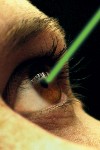Commercially available class 3A green laser pointers, which along with red laser pointers are used during lectures and presentations, can induce retinopathy, according to a study published in the May issue of Archives of Ophthalmology.1
The study was done on a 55-year-old woman who had a ring mela-noma in one eye and was scheduled for enucleation. Because enucleation was imminent, she agreed to have the retina of this eye exposed to a green laser pointer. The eye had 20/20 visual acuity, and the retina appeared healthy.
The researchers exposed the patients retina to the laser beam continuously for 60 seconds to the fovea, five minutes to a location five degrees below the fovea and 15 minutes to a location five degrees above the fovea. Normal blinking was permitted throughout the exposure. The power measurements of the laser measured 5 milliwatts (mW).
Some 24 hours after exposure, the researchers observed retinopathy, characterized by a yellowish discoloration, at the level of the retinal pigment epithelium (RPE) in the subfoveal section and at the location above the fovea that were exposed to the green beam for 15 minutes. At the six-day follow-up, they observed delicate granular irregularity at the level of the RPE.
By 20-days post-exposure, the abnormality at the fovea was primarily characterized by a more delicate, creamy discoloration. The patient sustained her pre-laser visual acuity of 20/20 at all of these follow-up visits.
In a previous study, the same researchers exposed three human eyes to red laser pointers (powers were 1, 2 and 5mW) for one, five and 15 minutes. None of the functional, ophthalmoscopic, histologic or ultrastructural abnormalities found could be attributed to the red laser pointers.2
The retina is increasingly sensitive to short wavelengths, and the melanin in the pigment epithelium absorbs more energy at shorter than longer wavelengths. So, the researchers were not surprised that the green laser pointer caused retinopathy.
The researchers conclude that this study should be a warning that exposure of the retina to light from a commercially available green laser pointer carries a real risk, and this risk appears to surpass that of the commercially available red laser pointers.
The study was done on a 55-year-old woman who had a ring mela-noma in one eye and was scheduled for enucleation. Because enucleation was imminent, she agreed to have the retina of this eye exposed to a green laser pointer. The eye had 20/20 visual acuity, and the retina appeared healthy.
The researchers exposed the patients retina to the laser beam continuously for 60 seconds to the fovea, five minutes to a location five degrees below the fovea and 15 minutes to a location five degrees above the fovea. Normal blinking was permitted throughout the exposure. The power measurements of the laser measured 5 milliwatts (mW).
Some 24 hours after exposure, the researchers observed retinopathy, characterized by a yellowish discoloration, at the level of the retinal pigment epithelium (RPE) in the subfoveal section and at the location above the fovea that were exposed to the green beam for 15 minutes. At the six-day follow-up, they observed delicate granular irregularity at the level of the RPE.
 |
By 20-days post-exposure, the abnormality at the fovea was primarily characterized by a more delicate, creamy discoloration. The patient sustained her pre-laser visual acuity of 20/20 at all of these follow-up visits.
In a previous study, the same researchers exposed three human eyes to red laser pointers (powers were 1, 2 and 5mW) for one, five and 15 minutes. None of the functional, ophthalmoscopic, histologic or ultrastructural abnormalities found could be attributed to the red laser pointers.2
The retina is increasingly sensitive to short wavelengths, and the melanin in the pigment epithelium absorbs more energy at shorter than longer wavelengths. So, the researchers were not surprised that the green laser pointer caused retinopathy.
The researchers conclude that this study should be a warning that exposure of the retina to light from a commercially available green laser pointer carries a real risk, and this risk appears to surpass that of the commercially available red laser pointers.
1. Robertson DM, McLaren JW, Salomao DR, Link TP. Retinopathy from a green laser pointer: a clinicopathologic study. Arch Ophthalmol 2005 May;123(5):629-33.
2. Robertson DM, Lim TH, Salamao DR, et al. Laser pointers and the human eye: a clinicopathologic study. Arch Ophthalmol 2000 Dec;118(12):1686-91.
Vol. No: 142:6Issue:
6/15/05

